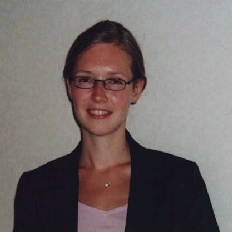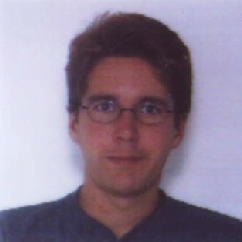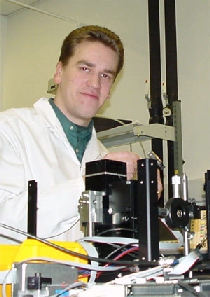First Medical Physics and Medical Engineering Day
|
|||
The aim of this thesis was to develop a method for measuring free drug concentration in mammalian neural tissue at different temperatures. Furthermore, the purpose was to find out how the biocompatibility of various monomers and polymers could be tested reliably. The method developed is based on the monotonic dependence of the photoresponse kinetics of mammalian photoreceptors on the concentration of the model drug (3-isobutyl-1-methylxanthine, IBMX). The changes in the photoresponse kinetics were followed by the electroretinogram (ERG) technique. Isolated retinas of the albino rat (Rattus norvegicus) were used as a preparation. In this thesis it was observed that the kinetics of linear-range photoresponses of rat rods is proportional to the square root of the concentration of IBMX. The calibration curve (the concentration of IBMX as a function of photoresponse kinetics) was used to determine the amount of IBMX released from polymeric structures in the concentration range 3-300 uM. It was also shown that rat retina can be used for testing of biocompatibility of various molecules as rod photoresponses are very sensitive to potentially hazardous molecules. As shown in this thesis the mammalian retina can be used as a very sensitive biosensor. The method developed will be described in an international serial publication. |
 |
||
Tommi Noponen, Helsinki University of Technology
|
|||
A one-channel frequency-domain instrument for physiological measurements has been developed earlier in the DOI-project in the Laboratory of Biomedical Engineering. In the frequency-domain technique, intensity-modulated light is delivered into the tissue and the modulation amplitude and phase are measured from the transmitted light. When the light transport is modeled in tissue, the optical properties of the tissue can be estimated using the measured data. Methods for expanding the one-channel instrument to an imaging device were developed in this work. First a commercial fiberoptic switch is presented for extending the number of source fibers from 1 to 16. A computer program was developed for controlling the switch. The receiving optics was expanded using time multiplexing. A chopper shutter was built for this purpose. The shutter is controlled with a stepper motor so that a single measurement bundle out of four possible can be selected active. The coupling of the active bundle is 85-90% and the leak of the passive bundles is approximately -26 dB. The shutter system can be used for topographical imaging applications. In the second part of this work, a four-channel digital lock-in amplifier (LIA) was developed. The LIA is used to measure the amplitude and phase of the signal. The design is based on digital signal processor technology. A DSP program for the LIA was programmed and a four-channel analog-to-digital converter board was designed for the extension of the DSP board. The noise level of the A/D converter board was approximately -86 dB. The LIA was connected to a PC and the performance of the four-channel LIA was compared with a commercial digital LIA (Stanford Research Systems, SR810). The amplitude and phase noise of both devices were approximately the same. |
 |
||
Marko Tirri, Tampere University of Technology
|
|||
The function of the constructed equipment is based on the measurement of fluorescence produced by two-photon excitation. The aim was to clarify the requirements for equipment and laser to realize dual-colour fluorescence correlation spectroscopy (FCS) by two-photon fluorescence excitation. Further aim was to clarify the possibility to realize a bioaffinity assay, in which fluorescent nanoparticles are used as label molecules and nanoparticle complexes produced by bioaffinity reaction are counted. Two-photon fluorescence excitation was performed by a mode-locked Nd:glass femtosecond laser, which can produce laser pulses that have duration of 120 fs and wavelength of 1060 nm. Two-photon excited dual-colour FCS realized by that kind of laser has not been published earlier in scientific literature. In those experiences the lasers have been titanium-sapphire-lasers functioning in lower wavelength range. The possibility to count biomolecules and nanoparticles in liquid with the constructed equipment was eluciated by measurements. It is possible to detect and count single photons by the measurement system. When calculating an auto-correlation function for the photon signal, it is possible to define size differences between molecules or molecule clusters. When measuring nanoparticles labeled with different fluorescent dyes cross-correlation can be calculated for these signals. Binding reactions between different particles can be observed by cross-correlation. |

|
||